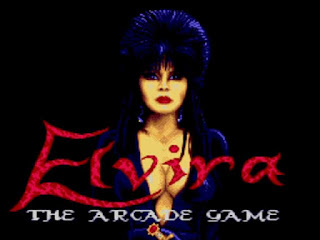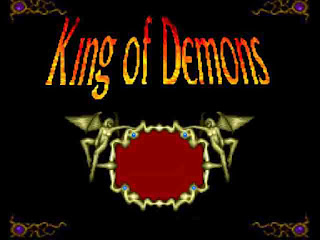Fire & Brimstone is the wondrous story of a journey into the very depths of evil - it is the tale of one man's historic quest to quench the flames of hell for ever.
The Norse kingdom is threatened by the iniquitous Hel, goddess of Niflheim, and purveyor of devilry, whose influence is permeating upwards from her inferno through the other eight worlds of the Norsemen. She aims to spread her godforsaken power until she controls all.
Thor is a man with a mission. A god with a goal. He has been selected by his fellow gods to attempt the near impossible - to travel through the Norse worlds until he reaches the source of Hel's wickedness. In the depths of depravity, he must extinguish the roaring satanic flames by destroying Hel herself. He'll need your help.
The journey will be long and arduous. Hel has sent evil creatures to meet him, delay him, and kill him. A variety of traps and pitfalls await. The reward for success is liberty. The consequence for failure is death.
- Nine levels of non-stop action against a formidable array of gruesome enemies.
- Amazing graphics, pounding soundtrack and challenging, addictive gameplay.
- Hidden rooms, potions and keys to find, and tricks, traps and puzzles to solve.
- 'Fire & Brimstone' is fiendishly clever, infernally combative and mesmerically addictive.
~ from the back of the box
Early platformers designed with the micro computers in mind quickly gained a reputation for being insanely difficult. Maybe it's the idea that a more complex machine will attract a more complex games designer. Perhaps it's the European design ethos where even drops of water are as deadly as a fire-breathing dragon. Could it be the lack of a standardised controller, with most opting for a single-button joystick layout? Either way, they're nigh-on impossible compared to what the consoles were producing at the time. 'Nintendo hard' games have got nothing on the likes of Shadow of the Beast, Cauldron or Beyond the Ice Palace.
Vectordean's Fire & Brimstone can easily be added to that list. Released in 1990, it was the last game to be published by Firebird, British Telecom's foray into the gaming industry before they were bought out by MicroProse. This single-screen platformer has you play as the Norse god Thor who's on a mission to thwart the evil machinations of Hel, goddess of death. This will take you down nine levels on the search for key pieces. Collect enough of them before defeating the end-of-level boss and you get to continue your journey to hell. Miss just one piece, and you'll be back to the start of the stage to hunt again (though collected keys will thankfully remain collected).
With its often spooky pixel art and an overwhelming amount of enemy sprites, you'd be forgiven in thinking this was a platformer in the same vein as Ghouls 'N Ghosts which coincidentally saw it ported to the Amiga that same year. It does look better than that port, sporting an art style far more in keeping with Capcom's original arcade release than the official Amiga game, but it plays drastically different. At its heart, Fire & Brimstone is more of a puzzle platformer. Not only does each screen offer a decent challenge to get from left to right, but most will also hold secrets and useful power-ups in hard-to-reach places.
Survive the level without finding all of the key pieces, and you'll have to do it all again (left).
Only when you have them all can you go to the next stage (right).
Only when you have them all can you go to the next stage (right).
Take the very first screen. An ogre is sleeping peacefully by a bonfire. Attack it with your fireball and it will wake up and walk ominously towards you. A single touch is enough to take down the mighty Thor reducing your lives from three to two. You somehow never have enough fireballs to kill it before he gets you, so on your second life you change tactics. He is too big to reliably jump over, even if you position yourself on top of the little mound and time it when the shielded beast is at the bottom. Another life gone. Perhaps you need to attack him from behind? So you sneak in closer to give it a try only for him to wake up when you're near. A panicked flurry of fireballs will do nothing but earn you a game over. On the very first screen! The answer to this first encounter, I found out after an embarrassing number of lives lost and continues taken, is to not kill him. Walk up to him to awake him from his slumber, then as he trundles towards you just walk on by. Do not attack him, do not try and jump over him. Simply stroll past like a good citizen. Arthur doesn't have this kind of trouble when fighting off Ghosts 'N Goblins!
Some screens are so flux with enemies that inching towards the right is met with projectiles from all angles. These smaller hits only take a small section from your health bar, but it's easy to get caught in a loop depleting it within seconds. Other attacks affect your movement. A hit from a witch could slow you to a crawl, give you warp speed or reverse your controls. There are a variety of potions to help you, though you can only collect two at once; tap the cursor keys for the left one and the number pad for the right (in its original control configuration at least - when not using a controller, I change it to Z and X respectively). Coming in four different colours, these are quite unique as far as power-ups go and are best used as an alternative way to navigate difficult obstacles or screens. Red potions send a lightning bolt crashing from the sky damaging all enemies on screen, but considering the speed in which they respawn it's pretty useless. Gold potions give you a higher jump for a short period which allows you to reach previously inaccessible ledges or rewards you with extra leeway on annoyingly precise long jumps. White potions light up dark rooms making previously invisible objects and platforms visible. Blue potions are the most useful. When drunk, a platform will appear that is pre-determined for each screen. This can make previously difficult screens a breeze to pass through but they can be easily wasted. When you collect a third potion, a random one you're holding will instantly be used and more often than not, it's the one you've been saving for later.
Sometimes, the only way to get past a difficult jump is with a platform-creation potion.
That spike pit on the right next to the fire is impossible to survive without it.
That spike pit on the right next to the fire is impossible to survive without it.
Other power-ups include weapons. You can carry two at any one time and the space bar (or any letter key) will swap between them. All are projectiles of some sort and affect some enemies differently. I mostly stuck with the fireball as it seemed to be the most powerful overall as well as the easiest to aim. Instant power-ups also exist including treasure for bonus points, watches for invincibility and ankhs for extra lives.
All these bonus items do nothing to aid in the extreme difficulty you'll face right from the off. The only way to play it is to know it. Know what to collect and where to use it, know how to attack and with what, know the secret doors and hidden rooms which are actually necessary to find. Some may enjoy the trial-and-error of it all, slowly uncovering each and every element the game has to offer, and with the unlimited lives cheat turned on, it plays rather well like it. You only go back to the beginning of the previous screen you died in so in this regards it's rather generous (although a larger health bar wouldn't go amiss). With only three lives, it's a chore-filled nightmare complete with frustrating and seemingly unfair deaths upon every step. It's one of those few games where the cheats aren't just cheats, but quality of life improvements and in my view is the only way to play this game. Turn them on and it's actually very enjoyable, turning Fire & Brimstone into a game I would recommend wholeheartedly.

To download the game, follow the link below. This custom installer exclusive to The Collection Chamber uses FS-UAE to emulate the Amiga version. Manual included. Read the ChamberNotes.txt for more detailed information. Tested on Windows 10.
File Size: 15.7 Mb. Install Size: 34.1 Mb. Need help? Consult the Collection Chamber FAQ
Download
Fire & Brimstone is © Vectordean Ltd & Firebird
Review, Cover Design and Installer created by me




















I don't know how accurate it this is, as I never had an Amiga, but my impression of the system was that it was always very spectacle-led, with fans and developers alike prizing its capacity for graphics and audio that had no match in the other PCs of the time and arguably not in the consoles either. Unfortunately game design often lagged behind with frustrating difficulty, unintuitive UIs and unresponsive controls, and trial-and-error gameplay thrown in to pad out the run time.
ReplyDeleteWhether there's some causal link there I don't know; it could be that prioritising one directly came at the cost of the other, or it may just be that the medium was young and designers were still cutting their teeth and casting about to find out what worked and what didn't.
You could be on to something there. My take is that with the Amiga and Atari ST following on from the success of the Commodore64, ZX Spectrum and Amstrad CPC in Europe, the popularity of the 'bedroom coder' is also a factor. Many development teams were generally smaller, younger and less experienced than those developing for consoles to the east and west of us.
DeleteCompare the 7-man team for Ghouls n Ghosts' original Arcade release (not to mention the additional teams assigned to each port) to the 3 people responsible for Fire & Brimstone on both the Amiga and Atari ST. I think this plays a role in the janky charm of Euro platformers - anyone could make and sell a game, so to stand out you had to look good. Plus the rife piracy may have played a role in a similar way to the rental industry causing the 'Nintendo hard' games.
It is very accurate. Many AMIGA games were little more than interactive tech demos. They looked and sounded amazing, but were not actually fun or interesting to play. Due to very low barriers of entry, the AMIGA and ST had many "indie" coders, which were basically kids with lots of programming talent and knew how to squeeze the maximum out of the hardware, but had little to know experience in actual game design.
DeleteThere is a wide variety of games but let's say that Amiga ones started to get (much!) better when the 8 bit machines fell behind. There are easy/beatable platformer action games on the Spectrum and Commodore which had a port in the Amiga, but the design shake really came from games directly designed in that computer like Another World or Flashback. Or Prince of Persia, before them. Games where the only punishment for dying is "try again", which was revolutionary.
DeleteAlso, the Amiga canon is... shaky to say the least. We are still depending on scores given by magazines at the time, and the magazines at the time didn't have the best credibility. I cannot understand the overestimation of games like Shadow of the Beast.